Understanding & Leading Change in Organizations: Impact, Drivers, and Measures
VerifiedAdded on 2023/06/10
|13
|5034
|256
AI Summary
This report discusses the impact of change on organizational strategy and operation, evaluating different organizational examples that disclose the impacts of change on the organizational strategy and operation. It assesses the different drivers for change, evaluates the ways in which internal and external drivers of change affect leadership, team and individual behaviours within an organisation, explains different barriers to change, and applies different leadership approaches to dealing with change in a range of organizational contexts. The report also suggests measures to minimize negative impacts of change.
Contribute Materials
Your contribution can guide someone’s learning journey. Share your
documents today.
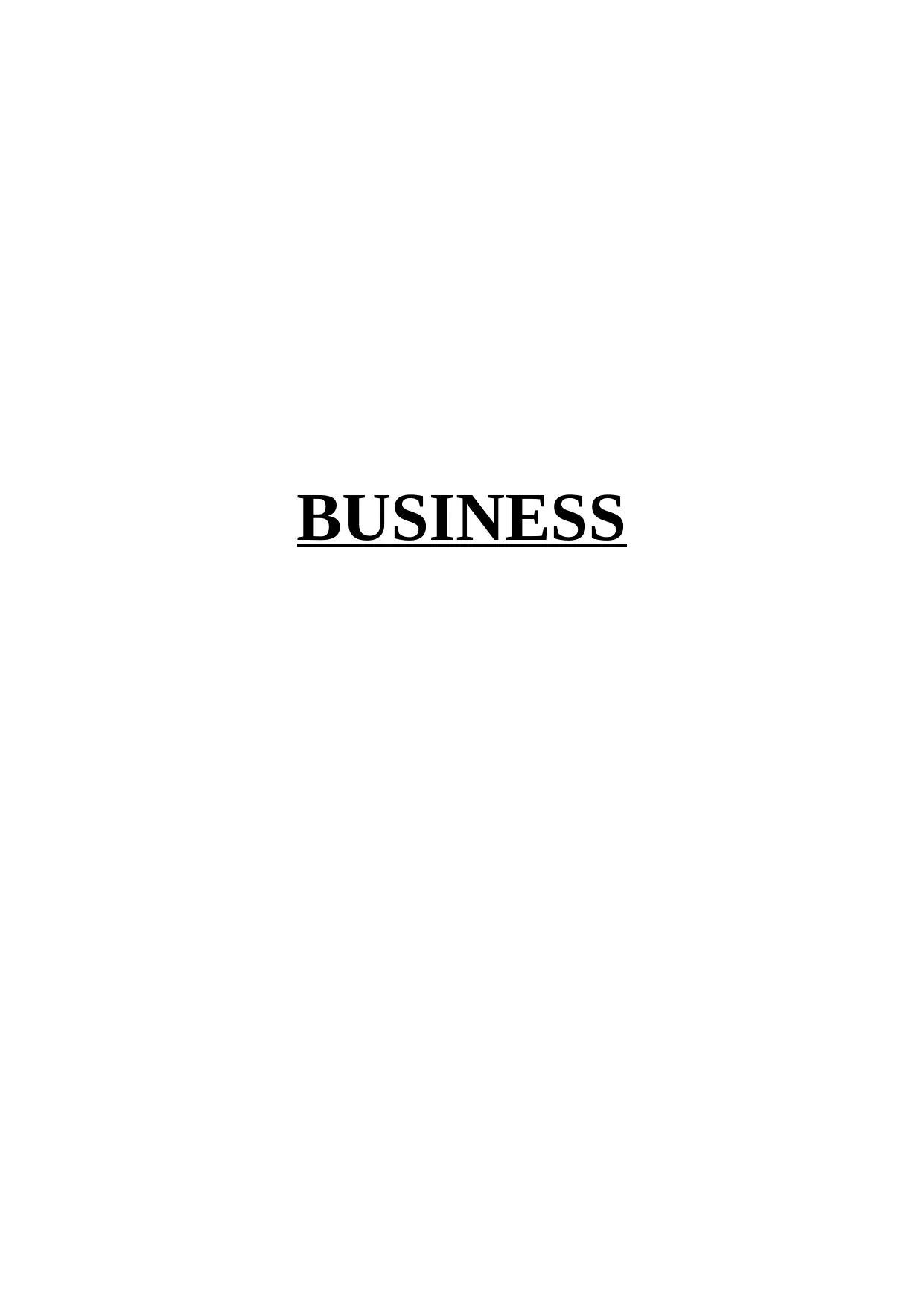
BUSINESS
Secure Best Marks with AI Grader
Need help grading? Try our AI Grader for instant feedback on your assignments.
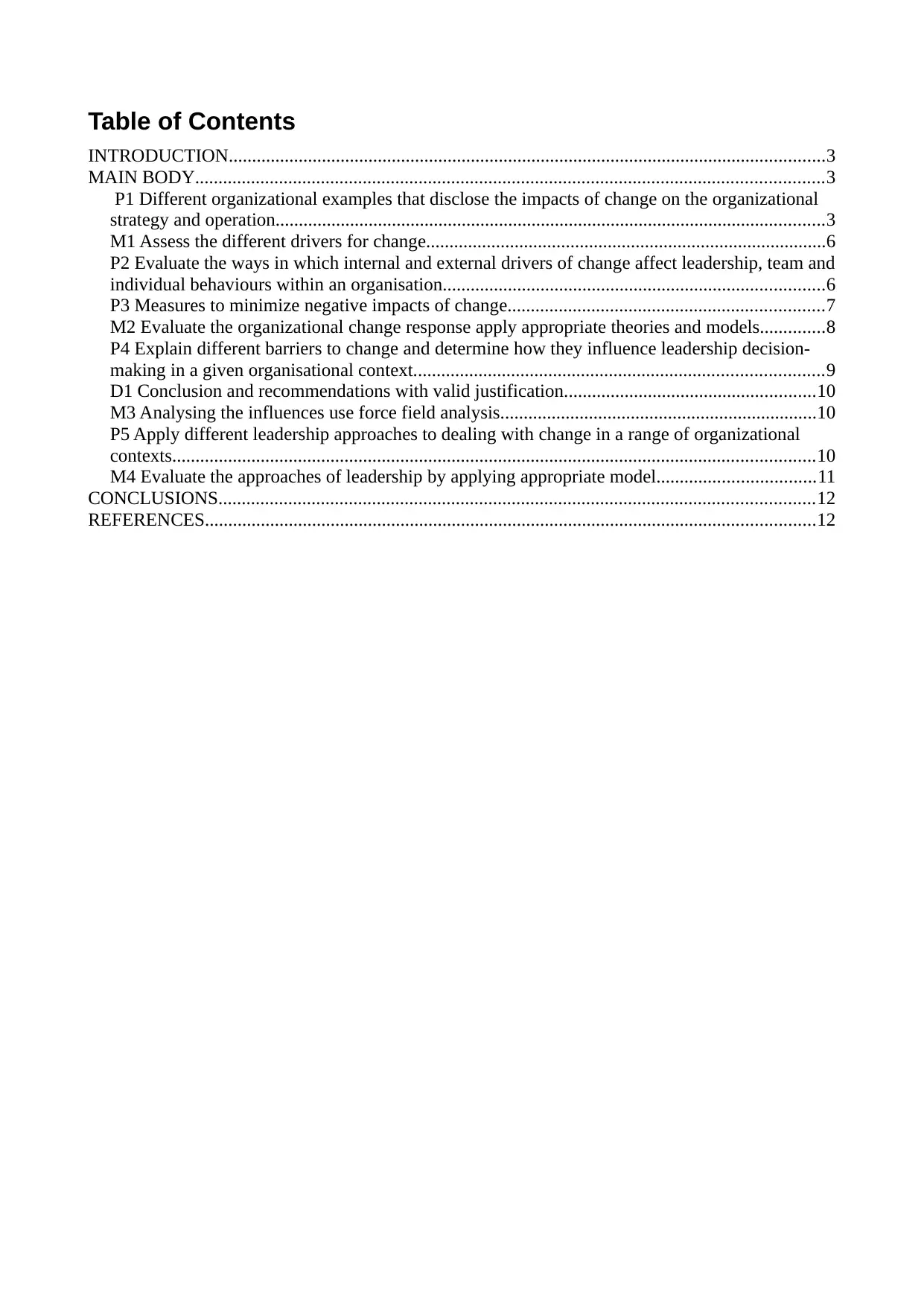
Table of Contents
INTRODUCTION................................................................................................................................3
MAIN BODY.......................................................................................................................................3
P1 Different organizational examples that disclose the impacts of change on the organizational
strategy and operation......................................................................................................................3
M1 Assess the different drivers for change......................................................................................6
P2 Evaluate the ways in which internal and external drivers of change affect leadership, team and
individual behaviours within an organisation..................................................................................6
P3 Measures to minimize negative impacts of change....................................................................7
M2 Evaluate the organizational change response apply appropriate theories and models..............8
P4 Explain different barriers to change and determine how they influence leadership decision-
making in a given organisational context........................................................................................9
D1 Conclusion and recommendations with valid justification......................................................10
M3 Analysing the influences use force field analysis....................................................................10
P5 Apply different leadership approaches to dealing with change in a range of organizational
contexts..........................................................................................................................................10
M4 Evaluate the approaches of leadership by applying appropriate model..................................11
CONCLUSIONS................................................................................................................................12
REFERENCES...................................................................................................................................12
INTRODUCTION................................................................................................................................3
MAIN BODY.......................................................................................................................................3
P1 Different organizational examples that disclose the impacts of change on the organizational
strategy and operation......................................................................................................................3
M1 Assess the different drivers for change......................................................................................6
P2 Evaluate the ways in which internal and external drivers of change affect leadership, team and
individual behaviours within an organisation..................................................................................6
P3 Measures to minimize negative impacts of change....................................................................7
M2 Evaluate the organizational change response apply appropriate theories and models..............8
P4 Explain different barriers to change and determine how they influence leadership decision-
making in a given organisational context........................................................................................9
D1 Conclusion and recommendations with valid justification......................................................10
M3 Analysing the influences use force field analysis....................................................................10
P5 Apply different leadership approaches to dealing with change in a range of organizational
contexts..........................................................................................................................................10
M4 Evaluate the approaches of leadership by applying appropriate model..................................11
CONCLUSIONS................................................................................................................................12
REFERENCES...................................................................................................................................12
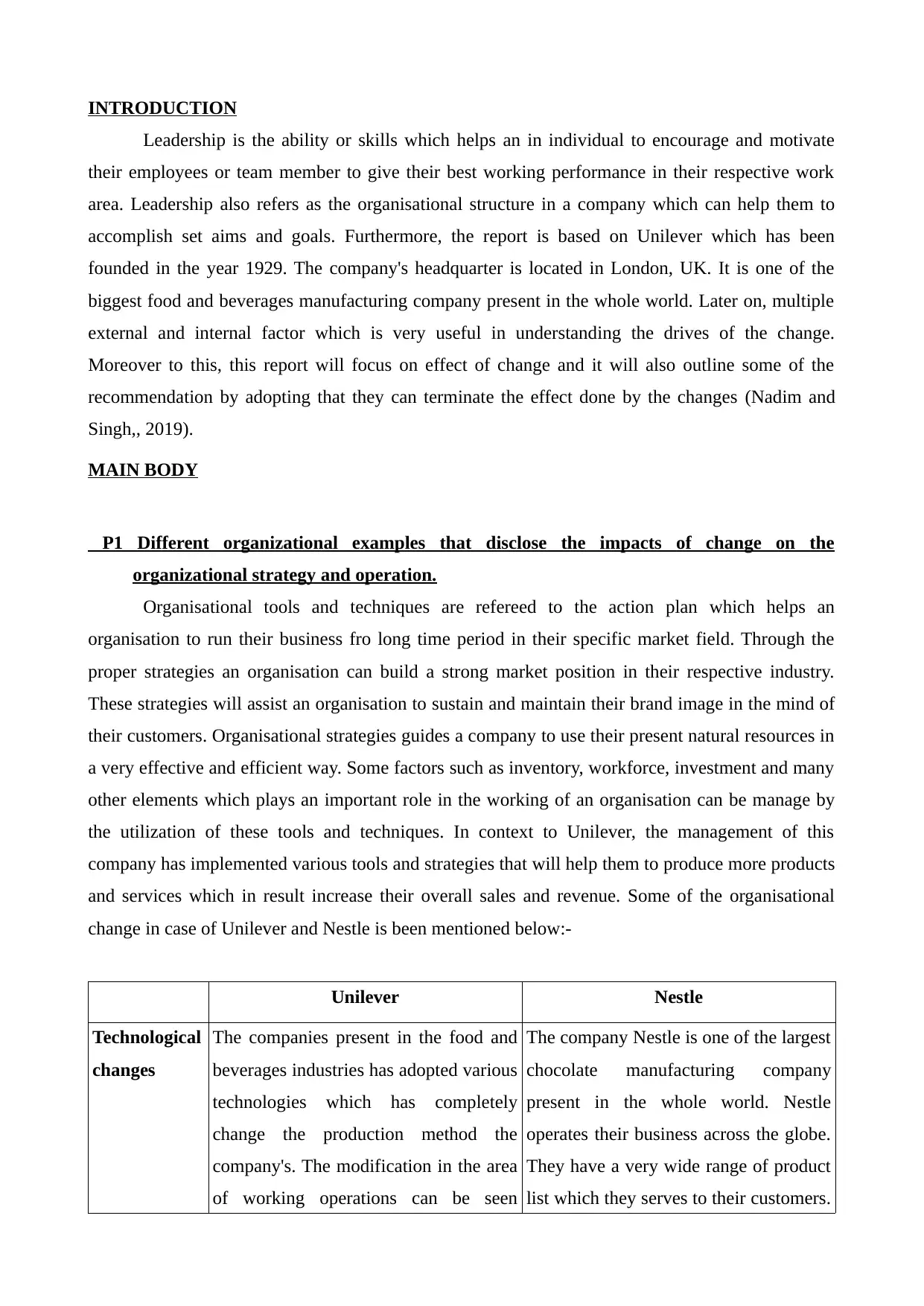
INTRODUCTION
Leadership is the ability or skills which helps an in individual to encourage and motivate
their employees or team member to give their best working performance in their respective work
area. Leadership also refers as the organisational structure in a company which can help them to
accomplish set aims and goals. Furthermore, the report is based on Unilever which has been
founded in the year 1929. The company's headquarter is located in London, UK. It is one of the
biggest food and beverages manufacturing company present in the whole world. Later on, multiple
external and internal factor which is very useful in understanding the drives of the change.
Moreover to this, this report will focus on effect of change and it will also outline some of the
recommendation by adopting that they can terminate the effect done by the changes (Nadim and
Singh,, 2019).
MAIN BODY
P1 Different organizational examples that disclose the impacts of change on the
organizational strategy and operation.
Organisational tools and techniques are refereed to the action plan which helps an
organisation to run their business fro long time period in their specific market field. Through the
proper strategies an organisation can build a strong market position in their respective industry.
These strategies will assist an organisation to sustain and maintain their brand image in the mind of
their customers. Organisational strategies guides a company to use their present natural resources in
a very effective and efficient way. Some factors such as inventory, workforce, investment and many
other elements which plays an important role in the working of an organisation can be manage by
the utilization of these tools and techniques. In context to Unilever, the management of this
company has implemented various tools and strategies that will help them to produce more products
and services which in result increase their overall sales and revenue. Some of the organisational
change in case of Unilever and Nestle is been mentioned below:-
Unilever Nestle
Technological
changes
The companies present in the food and
beverages industries has adopted various
technologies which has completely
change the production method the
company's. The modification in the area
of working operations can be seen
The company Nestle is one of the largest
chocolate manufacturing company
present in the whole world. Nestle
operates their business across the globe.
They have a very wide range of product
list which they serves to their customers.
Leadership is the ability or skills which helps an in individual to encourage and motivate
their employees or team member to give their best working performance in their respective work
area. Leadership also refers as the organisational structure in a company which can help them to
accomplish set aims and goals. Furthermore, the report is based on Unilever which has been
founded in the year 1929. The company's headquarter is located in London, UK. It is one of the
biggest food and beverages manufacturing company present in the whole world. Later on, multiple
external and internal factor which is very useful in understanding the drives of the change.
Moreover to this, this report will focus on effect of change and it will also outline some of the
recommendation by adopting that they can terminate the effect done by the changes (Nadim and
Singh,, 2019).
MAIN BODY
P1 Different organizational examples that disclose the impacts of change on the
organizational strategy and operation.
Organisational tools and techniques are refereed to the action plan which helps an
organisation to run their business fro long time period in their specific market field. Through the
proper strategies an organisation can build a strong market position in their respective industry.
These strategies will assist an organisation to sustain and maintain their brand image in the mind of
their customers. Organisational strategies guides a company to use their present natural resources in
a very effective and efficient way. Some factors such as inventory, workforce, investment and many
other elements which plays an important role in the working of an organisation can be manage by
the utilization of these tools and techniques. In context to Unilever, the management of this
company has implemented various tools and strategies that will help them to produce more products
and services which in result increase their overall sales and revenue. Some of the organisational
change in case of Unilever and Nestle is been mentioned below:-
Unilever Nestle
Technological
changes
The companies present in the food and
beverages industries has adopted various
technologies which has completely
change the production method the
company's. The modification in the area
of working operations can be seen
The company Nestle is one of the largest
chocolate manufacturing company
present in the whole world. Nestle
operates their business across the globe.
They have a very wide range of product
list which they serves to their customers.
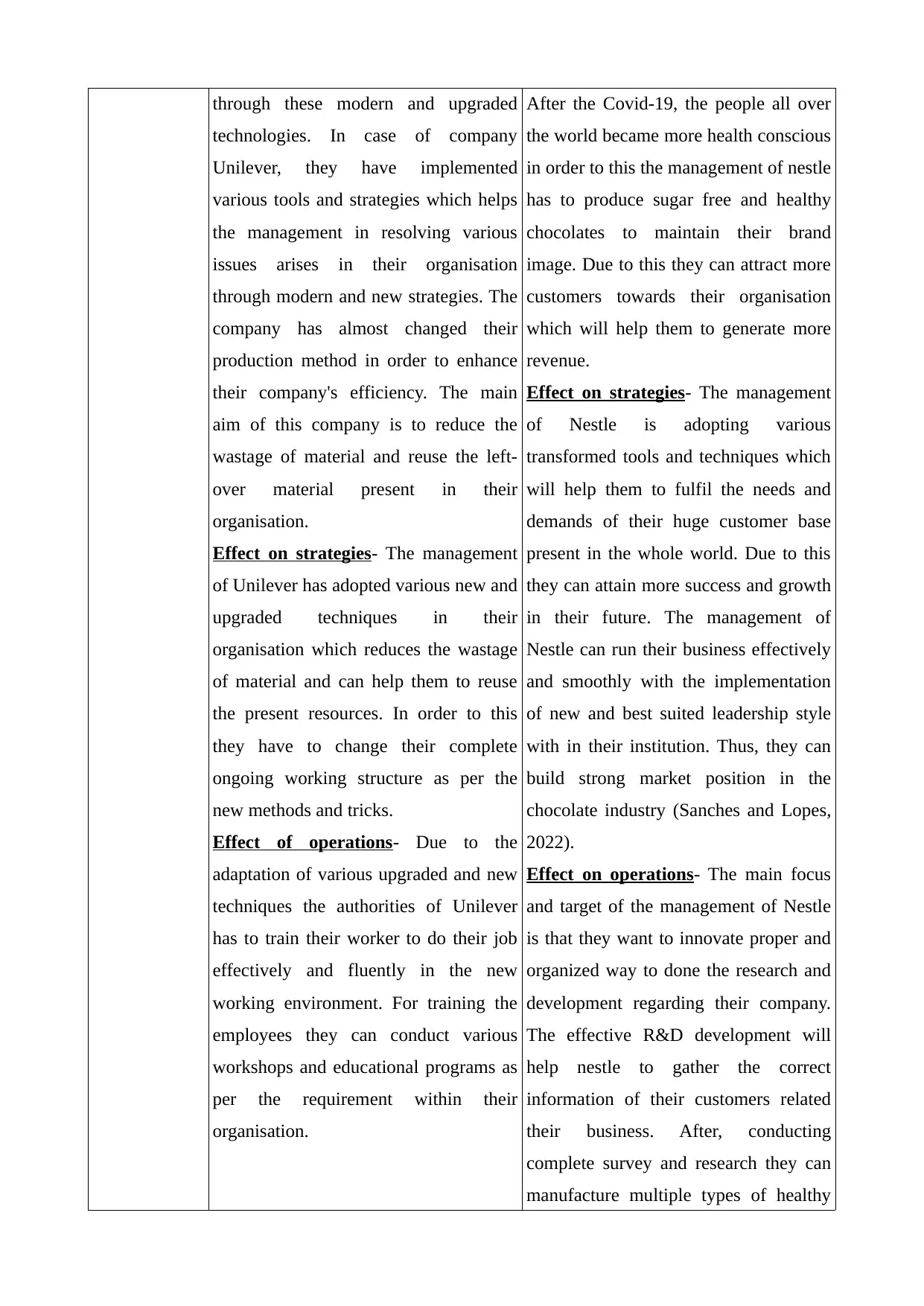
through these modern and upgraded
technologies. In case of company
Unilever, they have implemented
various tools and strategies which helps
the management in resolving various
issues arises in their organisation
through modern and new strategies. The
company has almost changed their
production method in order to enhance
their company's efficiency. The main
aim of this company is to reduce the
wastage of material and reuse the left-
over material present in their
organisation.
Effect on strategies- The management
of Unilever has adopted various new and
upgraded techniques in their
organisation which reduces the wastage
of material and can help them to reuse
the present resources. In order to this
they have to change their complete
ongoing working structure as per the
new methods and tricks.
Effect of operations- Due to the
adaptation of various upgraded and new
techniques the authorities of Unilever
has to train their worker to do their job
effectively and fluently in the new
working environment. For training the
employees they can conduct various
workshops and educational programs as
per the requirement within their
organisation.
After the Covid-19, the people all over
the world became more health conscious
in order to this the management of nestle
has to produce sugar free and healthy
chocolates to maintain their brand
image. Due to this they can attract more
customers towards their organisation
which will help them to generate more
revenue.
Effect on strategies- The management
of Nestle is adopting various
transformed tools and techniques which
will help them to fulfil the needs and
demands of their huge customer base
present in the whole world. Due to this
they can attain more success and growth
in their future. The management of
Nestle can run their business effectively
and smoothly with the implementation
of new and best suited leadership style
with in their institution. Thus, they can
build strong market position in the
chocolate industry (Sanches and Lopes,
2022).
Effect on operations- The main focus
and target of the management of Nestle
is that they want to innovate proper and
organized way to done the research and
development regarding their company.
The effective R&D development will
help nestle to gather the correct
information of their customers related
their business. After, conducting
complete survey and research they can
manufacture multiple types of healthy
technologies. In case of company
Unilever, they have implemented
various tools and strategies which helps
the management in resolving various
issues arises in their organisation
through modern and new strategies. The
company has almost changed their
production method in order to enhance
their company's efficiency. The main
aim of this company is to reduce the
wastage of material and reuse the left-
over material present in their
organisation.
Effect on strategies- The management
of Unilever has adopted various new and
upgraded techniques in their
organisation which reduces the wastage
of material and can help them to reuse
the present resources. In order to this
they have to change their complete
ongoing working structure as per the
new methods and tricks.
Effect of operations- Due to the
adaptation of various upgraded and new
techniques the authorities of Unilever
has to train their worker to do their job
effectively and fluently in the new
working environment. For training the
employees they can conduct various
workshops and educational programs as
per the requirement within their
organisation.
After the Covid-19, the people all over
the world became more health conscious
in order to this the management of nestle
has to produce sugar free and healthy
chocolates to maintain their brand
image. Due to this they can attract more
customers towards their organisation
which will help them to generate more
revenue.
Effect on strategies- The management
of Nestle is adopting various
transformed tools and techniques which
will help them to fulfil the needs and
demands of their huge customer base
present in the whole world. Due to this
they can attain more success and growth
in their future. The management of
Nestle can run their business effectively
and smoothly with the implementation
of new and best suited leadership style
with in their institution. Thus, they can
build strong market position in the
chocolate industry (Sanches and Lopes,
2022).
Effect on operations- The main focus
and target of the management of Nestle
is that they want to innovate proper and
organized way to done the research and
development regarding their company.
The effective R&D development will
help nestle to gather the correct
information of their customers related
their business. After, conducting
complete survey and research they can
manufacture multiple types of healthy
Secure Best Marks with AI Grader
Need help grading? Try our AI Grader for instant feedback on your assignments.
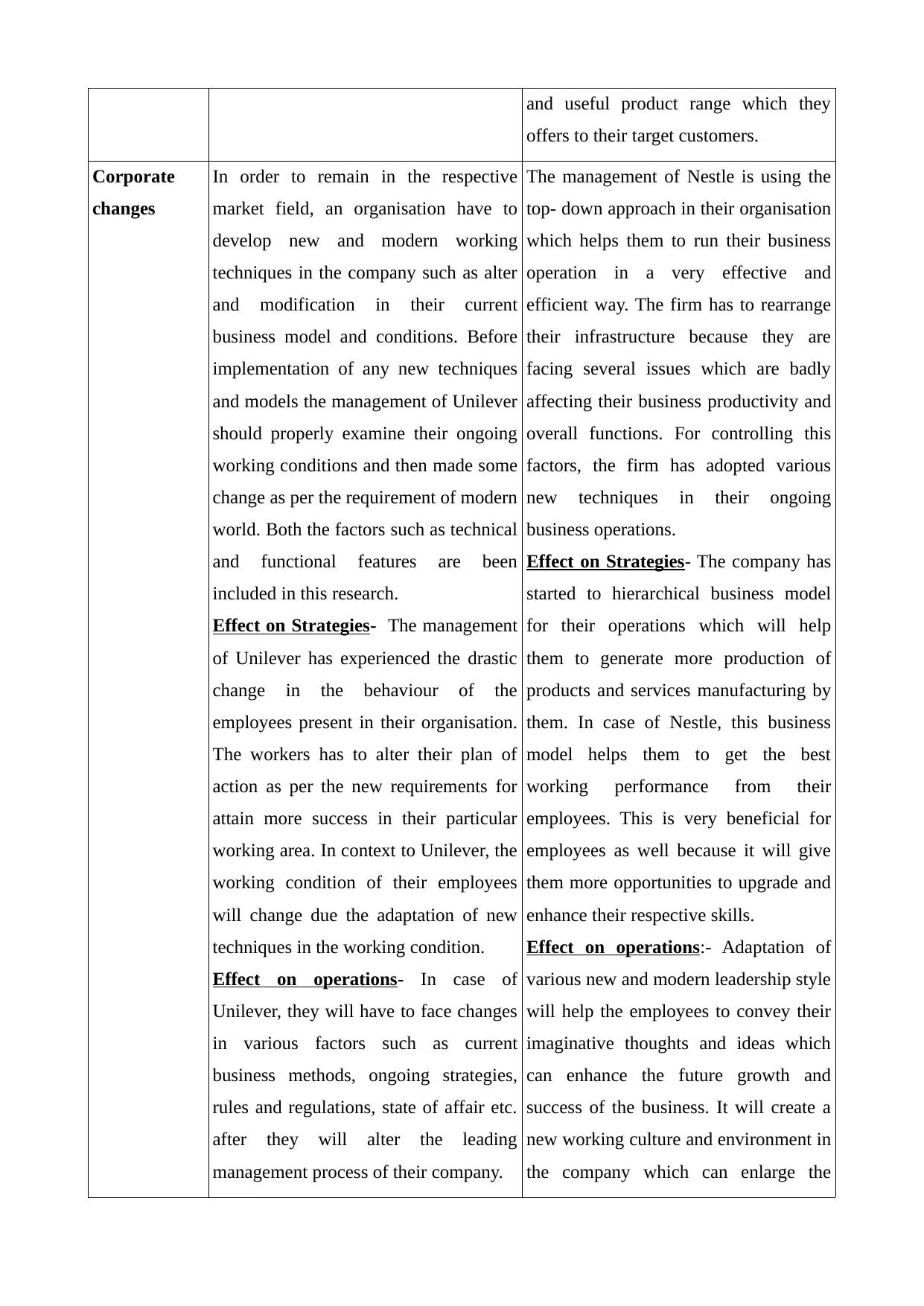
and useful product range which they
offers to their target customers.
Corporate
changes
In order to remain in the respective
market field, an organisation have to
develop new and modern working
techniques in the company such as alter
and modification in their current
business model and conditions. Before
implementation of any new techniques
and models the management of Unilever
should properly examine their ongoing
working conditions and then made some
change as per the requirement of modern
world. Both the factors such as technical
and functional features are been
included in this research.
Effect on Strategies- The management
of Unilever has experienced the drastic
change in the behaviour of the
employees present in their organisation.
The workers has to alter their plan of
action as per the new requirements for
attain more success in their particular
working area. In context to Unilever, the
working condition of their employees
will change due the adaptation of new
techniques in the working condition.
Effect on operations- In case of
Unilever, they will have to face changes
in various factors such as current
business methods, ongoing strategies,
rules and regulations, state of affair etc.
after they will alter the leading
management process of their company.
The management of Nestle is using the
top- down approach in their organisation
which helps them to run their business
operation in a very effective and
efficient way. The firm has to rearrange
their infrastructure because they are
facing several issues which are badly
affecting their business productivity and
overall functions. For controlling this
factors, the firm has adopted various
new techniques in their ongoing
business operations.
Effect on Strategies- The company has
started to hierarchical business model
for their operations which will help
them to generate more production of
products and services manufacturing by
them. In case of Nestle, this business
model helps them to get the best
working performance from their
employees. This is very beneficial for
employees as well because it will give
them more opportunities to upgrade and
enhance their respective skills.
Effect on operations:- Adaptation of
various new and modern leadership style
will help the employees to convey their
imaginative thoughts and ideas which
can enhance the future growth and
success of the business. It will create a
new working culture and environment in
the company which can enlarge the
offers to their target customers.
Corporate
changes
In order to remain in the respective
market field, an organisation have to
develop new and modern working
techniques in the company such as alter
and modification in their current
business model and conditions. Before
implementation of any new techniques
and models the management of Unilever
should properly examine their ongoing
working conditions and then made some
change as per the requirement of modern
world. Both the factors such as technical
and functional features are been
included in this research.
Effect on Strategies- The management
of Unilever has experienced the drastic
change in the behaviour of the
employees present in their organisation.
The workers has to alter their plan of
action as per the new requirements for
attain more success in their particular
working area. In context to Unilever, the
working condition of their employees
will change due the adaptation of new
techniques in the working condition.
Effect on operations- In case of
Unilever, they will have to face changes
in various factors such as current
business methods, ongoing strategies,
rules and regulations, state of affair etc.
after they will alter the leading
management process of their company.
The management of Nestle is using the
top- down approach in their organisation
which helps them to run their business
operation in a very effective and
efficient way. The firm has to rearrange
their infrastructure because they are
facing several issues which are badly
affecting their business productivity and
overall functions. For controlling this
factors, the firm has adopted various
new techniques in their ongoing
business operations.
Effect on Strategies- The company has
started to hierarchical business model
for their operations which will help
them to generate more production of
products and services manufacturing by
them. In case of Nestle, this business
model helps them to get the best
working performance from their
employees. This is very beneficial for
employees as well because it will give
them more opportunities to upgrade and
enhance their respective skills.
Effect on operations:- Adaptation of
various new and modern leadership style
will help the employees to convey their
imaginative thoughts and ideas which
can enhance the future growth and
success of the business. It will create a
new working culture and environment in
the company which can enlarge the
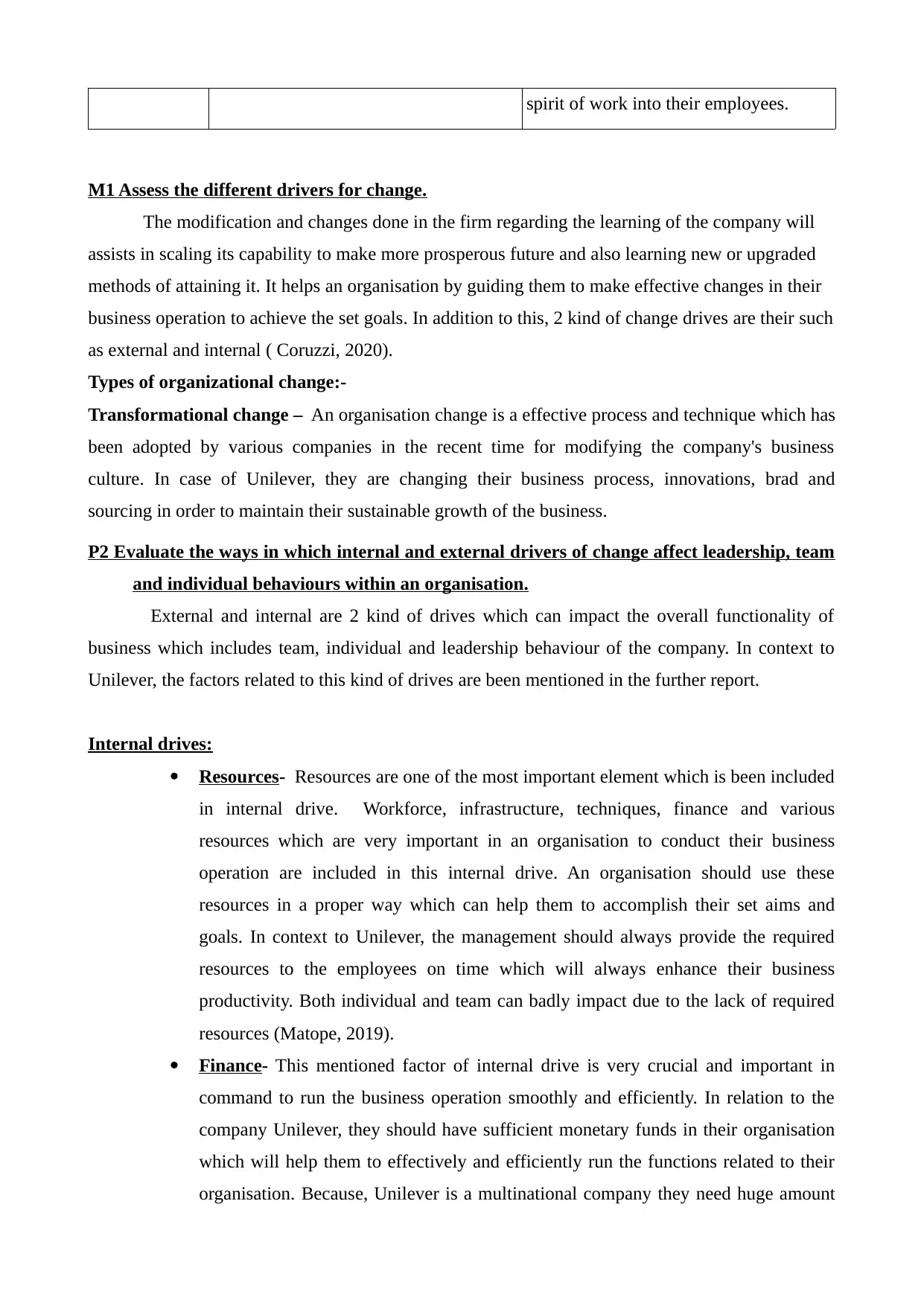
spirit of work into their employees.
M1 Assess the different drivers for change.
The modification and changes done in the firm regarding the learning of the company will
assists in scaling its capability to make more prosperous future and also learning new or upgraded
methods of attaining it. It helps an organisation by guiding them to make effective changes in their
business operation to achieve the set goals. In addition to this, 2 kind of change drives are their such
as external and internal ( Coruzzi, 2020).
Types of organizational change:-
Transformational change – An organisation change is a effective process and technique which has
been adopted by various companies in the recent time for modifying the company's business
culture. In case of Unilever, they are changing their business process, innovations, brad and
sourcing in order to maintain their sustainable growth of the business.
P2 Evaluate the ways in which internal and external drivers of change affect leadership, team
and individual behaviours within an organisation.
External and internal are 2 kind of drives which can impact the overall functionality of
business which includes team, individual and leadership behaviour of the company. In context to
Unilever, the factors related to this kind of drives are been mentioned in the further report.
Internal drives:
Resources- Resources are one of the most important element which is been included
in internal drive. Workforce, infrastructure, techniques, finance and various
resources which are very important in an organisation to conduct their business
operation are included in this internal drive. An organisation should use these
resources in a proper way which can help them to accomplish their set aims and
goals. In context to Unilever, the management should always provide the required
resources to the employees on time which will always enhance their business
productivity. Both individual and team can badly impact due to the lack of required
resources (Matope, 2019).
Finance- This mentioned factor of internal drive is very crucial and important in
command to run the business operation smoothly and efficiently. In relation to the
company Unilever, they should have sufficient monetary funds in their organisation
which will help them to effectively and efficiently run the functions related to their
organisation. Because, Unilever is a multinational company they need huge amount
M1 Assess the different drivers for change.
The modification and changes done in the firm regarding the learning of the company will
assists in scaling its capability to make more prosperous future and also learning new or upgraded
methods of attaining it. It helps an organisation by guiding them to make effective changes in their
business operation to achieve the set goals. In addition to this, 2 kind of change drives are their such
as external and internal ( Coruzzi, 2020).
Types of organizational change:-
Transformational change – An organisation change is a effective process and technique which has
been adopted by various companies in the recent time for modifying the company's business
culture. In case of Unilever, they are changing their business process, innovations, brad and
sourcing in order to maintain their sustainable growth of the business.
P2 Evaluate the ways in which internal and external drivers of change affect leadership, team
and individual behaviours within an organisation.
External and internal are 2 kind of drives which can impact the overall functionality of
business which includes team, individual and leadership behaviour of the company. In context to
Unilever, the factors related to this kind of drives are been mentioned in the further report.
Internal drives:
Resources- Resources are one of the most important element which is been included
in internal drive. Workforce, infrastructure, techniques, finance and various
resources which are very important in an organisation to conduct their business
operation are included in this internal drive. An organisation should use these
resources in a proper way which can help them to accomplish their set aims and
goals. In context to Unilever, the management should always provide the required
resources to the employees on time which will always enhance their business
productivity. Both individual and team can badly impact due to the lack of required
resources (Matope, 2019).
Finance- This mentioned factor of internal drive is very crucial and important in
command to run the business operation smoothly and efficiently. In relation to the
company Unilever, they should have sufficient monetary funds in their organisation
which will help them to effectively and efficiently run the functions related to their
organisation. Because, Unilever is a multinational company they need huge amount
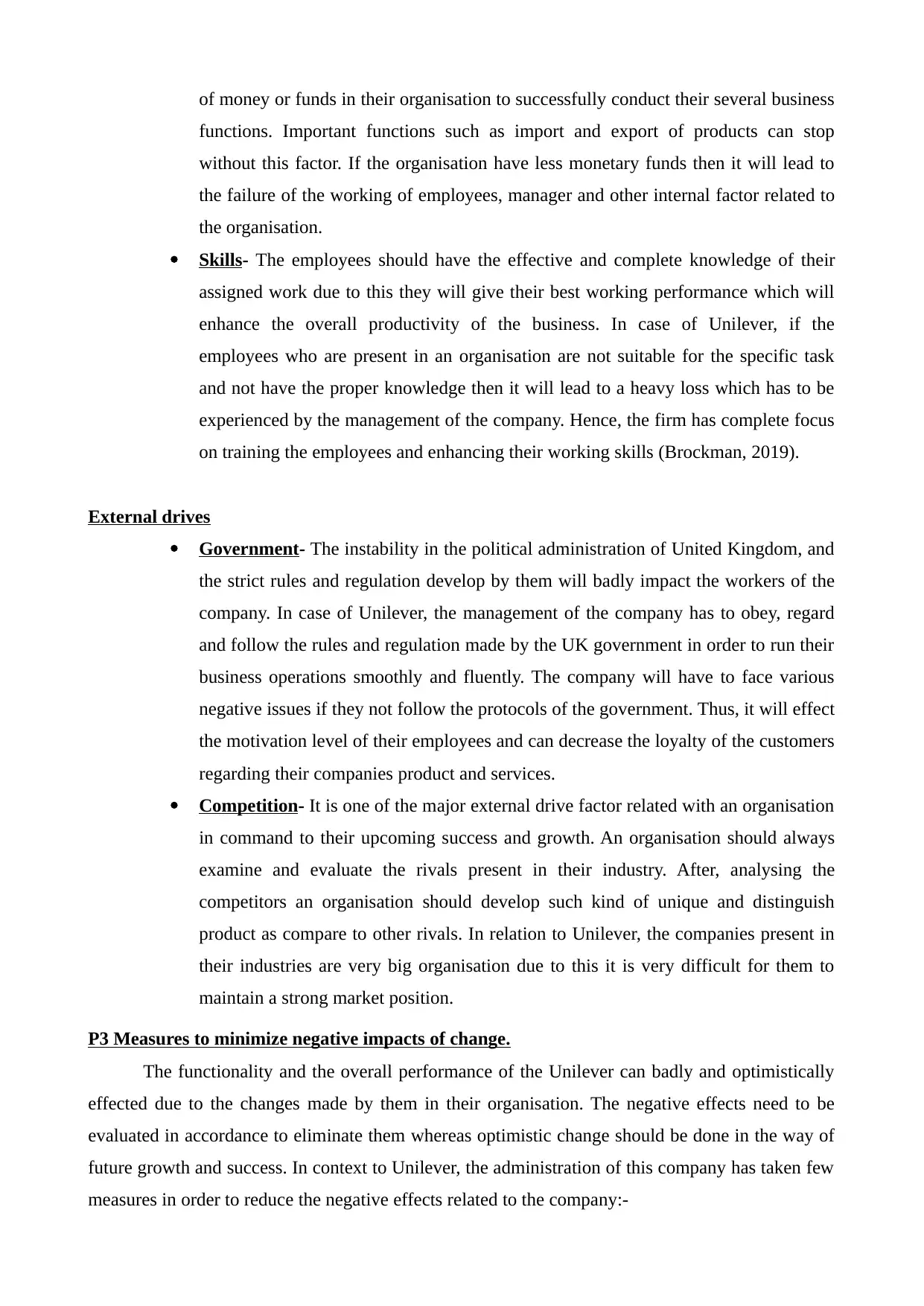
of money or funds in their organisation to successfully conduct their several business
functions. Important functions such as import and export of products can stop
without this factor. If the organisation have less monetary funds then it will lead to
the failure of the working of employees, manager and other internal factor related to
the organisation.
Skills- The employees should have the effective and complete knowledge of their
assigned work due to this they will give their best working performance which will
enhance the overall productivity of the business. In case of Unilever, if the
employees who are present in an organisation are not suitable for the specific task
and not have the proper knowledge then it will lead to a heavy loss which has to be
experienced by the management of the company. Hence, the firm has complete focus
on training the employees and enhancing their working skills (Brockman, 2019).
External drives
Government- The instability in the political administration of United Kingdom, and
the strict rules and regulation develop by them will badly impact the workers of the
company. In case of Unilever, the management of the company has to obey, regard
and follow the rules and regulation made by the UK government in order to run their
business operations smoothly and fluently. The company will have to face various
negative issues if they not follow the protocols of the government. Thus, it will effect
the motivation level of their employees and can decrease the loyalty of the customers
regarding their companies product and services.
Competition- It is one of the major external drive factor related with an organisation
in command to their upcoming success and growth. An organisation should always
examine and evaluate the rivals present in their industry. After, analysing the
competitors an organisation should develop such kind of unique and distinguish
product as compare to other rivals. In relation to Unilever, the companies present in
their industries are very big organisation due to this it is very difficult for them to
maintain a strong market position.
P3 Measures to minimize negative impacts of change.
The functionality and the overall performance of the Unilever can badly and optimistically
effected due to the changes made by them in their organisation. The negative effects need to be
evaluated in accordance to eliminate them whereas optimistic change should be done in the way of
future growth and success. In context to Unilever, the administration of this company has taken few
measures in order to reduce the negative effects related to the company:-
functions. Important functions such as import and export of products can stop
without this factor. If the organisation have less monetary funds then it will lead to
the failure of the working of employees, manager and other internal factor related to
the organisation.
Skills- The employees should have the effective and complete knowledge of their
assigned work due to this they will give their best working performance which will
enhance the overall productivity of the business. In case of Unilever, if the
employees who are present in an organisation are not suitable for the specific task
and not have the proper knowledge then it will lead to a heavy loss which has to be
experienced by the management of the company. Hence, the firm has complete focus
on training the employees and enhancing their working skills (Brockman, 2019).
External drives
Government- The instability in the political administration of United Kingdom, and
the strict rules and regulation develop by them will badly impact the workers of the
company. In case of Unilever, the management of the company has to obey, regard
and follow the rules and regulation made by the UK government in order to run their
business operations smoothly and fluently. The company will have to face various
negative issues if they not follow the protocols of the government. Thus, it will effect
the motivation level of their employees and can decrease the loyalty of the customers
regarding their companies product and services.
Competition- It is one of the major external drive factor related with an organisation
in command to their upcoming success and growth. An organisation should always
examine and evaluate the rivals present in their industry. After, analysing the
competitors an organisation should develop such kind of unique and distinguish
product as compare to other rivals. In relation to Unilever, the companies present in
their industries are very big organisation due to this it is very difficult for them to
maintain a strong market position.
P3 Measures to minimize negative impacts of change.
The functionality and the overall performance of the Unilever can badly and optimistically
effected due to the changes made by them in their organisation. The negative effects need to be
evaluated in accordance to eliminate them whereas optimistic change should be done in the way of
future growth and success. In context to Unilever, the administration of this company has taken few
measures in order to reduce the negative effects related to the company:-
Paraphrase This Document
Need a fresh take? Get an instant paraphrase of this document with our AI Paraphraser
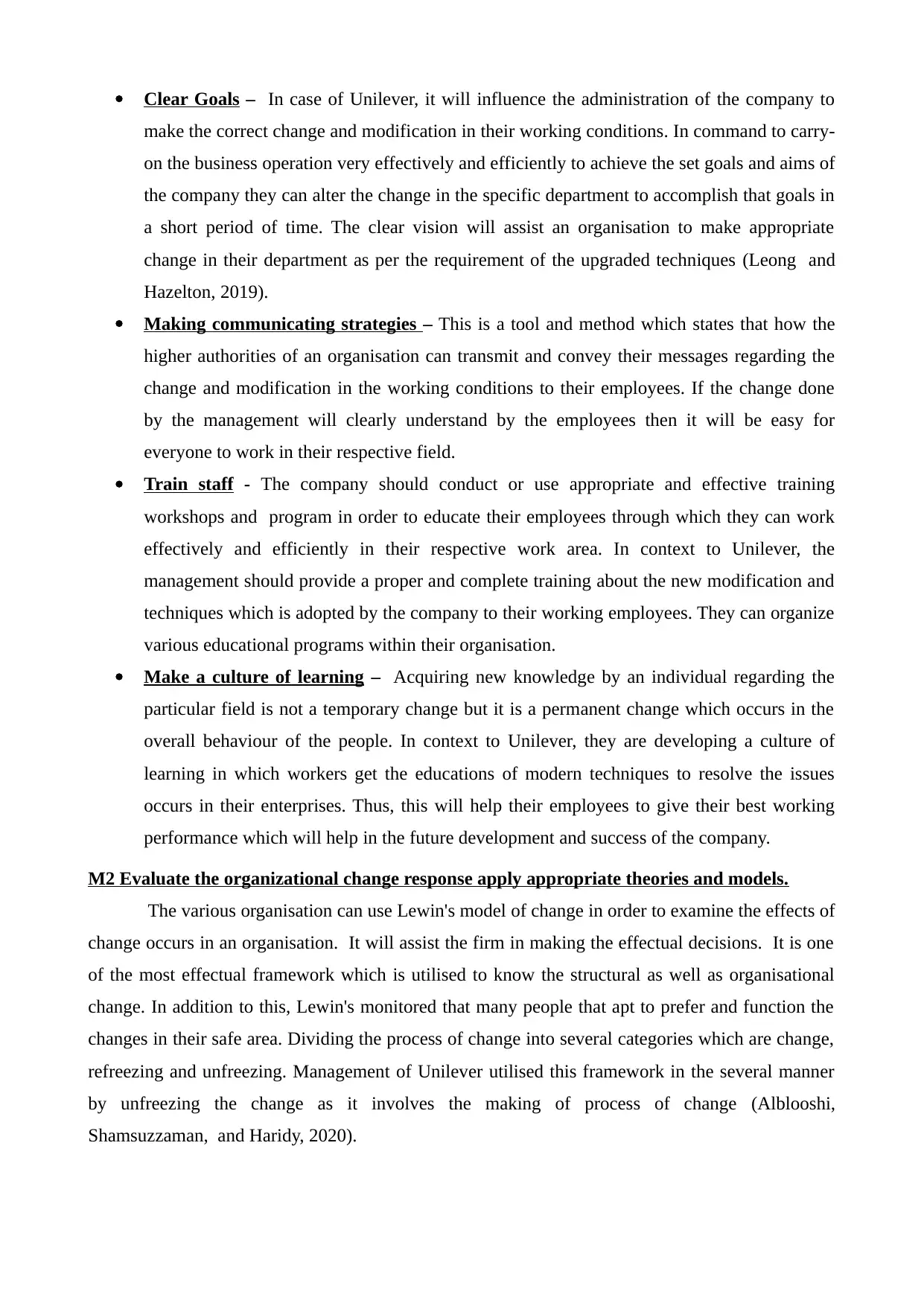
Clear Goals – In case of Unilever, it will influence the administration of the company to
make the correct change and modification in their working conditions. In command to carry-
on the business operation very effectively and efficiently to achieve the set goals and aims of
the company they can alter the change in the specific department to accomplish that goals in
a short period of time. The clear vision will assist an organisation to make appropriate
change in their department as per the requirement of the upgraded techniques (Leong and
Hazelton, 2019).
Making communicating strategies – This is a tool and method which states that how the
higher authorities of an organisation can transmit and convey their messages regarding the
change and modification in the working conditions to their employees. If the change done
by the management will clearly understand by the employees then it will be easy for
everyone to work in their respective field.
Train staff - The company should conduct or use appropriate and effective training
workshops and program in order to educate their employees through which they can work
effectively and efficiently in their respective work area. In context to Unilever, the
management should provide a proper and complete training about the new modification and
techniques which is adopted by the company to their working employees. They can organize
various educational programs within their organisation.
Make a culture of learning – Acquiring new knowledge by an individual regarding the
particular field is not a temporary change but it is a permanent change which occurs in the
overall behaviour of the people. In context to Unilever, they are developing a culture of
learning in which workers get the educations of modern techniques to resolve the issues
occurs in their enterprises. Thus, this will help their employees to give their best working
performance which will help in the future development and success of the company.
M2 Evaluate the organizational change response apply appropriate theories and models.
The various organisation can use Lewin's model of change in order to examine the effects of
change occurs in an organisation. It will assist the firm in making the effectual decisions. It is one
of the most effectual framework which is utilised to know the structural as well as organisational
change. In addition to this, Lewin's monitored that many people that apt to prefer and function the
changes in their safe area. Dividing the process of change into several categories which are change,
refreezing and unfreezing. Management of Unilever utilised this framework in the several manner
by unfreezing the change as it involves the making of process of change (Alblooshi,
Shamsuzzaman, and Haridy, 2020).
make the correct change and modification in their working conditions. In command to carry-
on the business operation very effectively and efficiently to achieve the set goals and aims of
the company they can alter the change in the specific department to accomplish that goals in
a short period of time. The clear vision will assist an organisation to make appropriate
change in their department as per the requirement of the upgraded techniques (Leong and
Hazelton, 2019).
Making communicating strategies – This is a tool and method which states that how the
higher authorities of an organisation can transmit and convey their messages regarding the
change and modification in the working conditions to their employees. If the change done
by the management will clearly understand by the employees then it will be easy for
everyone to work in their respective field.
Train staff - The company should conduct or use appropriate and effective training
workshops and program in order to educate their employees through which they can work
effectively and efficiently in their respective work area. In context to Unilever, the
management should provide a proper and complete training about the new modification and
techniques which is adopted by the company to their working employees. They can organize
various educational programs within their organisation.
Make a culture of learning – Acquiring new knowledge by an individual regarding the
particular field is not a temporary change but it is a permanent change which occurs in the
overall behaviour of the people. In context to Unilever, they are developing a culture of
learning in which workers get the educations of modern techniques to resolve the issues
occurs in their enterprises. Thus, this will help their employees to give their best working
performance which will help in the future development and success of the company.
M2 Evaluate the organizational change response apply appropriate theories and models.
The various organisation can use Lewin's model of change in order to examine the effects of
change occurs in an organisation. It will assist the firm in making the effectual decisions. It is one
of the most effectual framework which is utilised to know the structural as well as organisational
change. In addition to this, Lewin's monitored that many people that apt to prefer and function the
changes in their safe area. Dividing the process of change into several categories which are change,
refreezing and unfreezing. Management of Unilever utilised this framework in the several manner
by unfreezing the change as it involves the making of process of change (Alblooshi,
Shamsuzzaman, and Haridy, 2020).
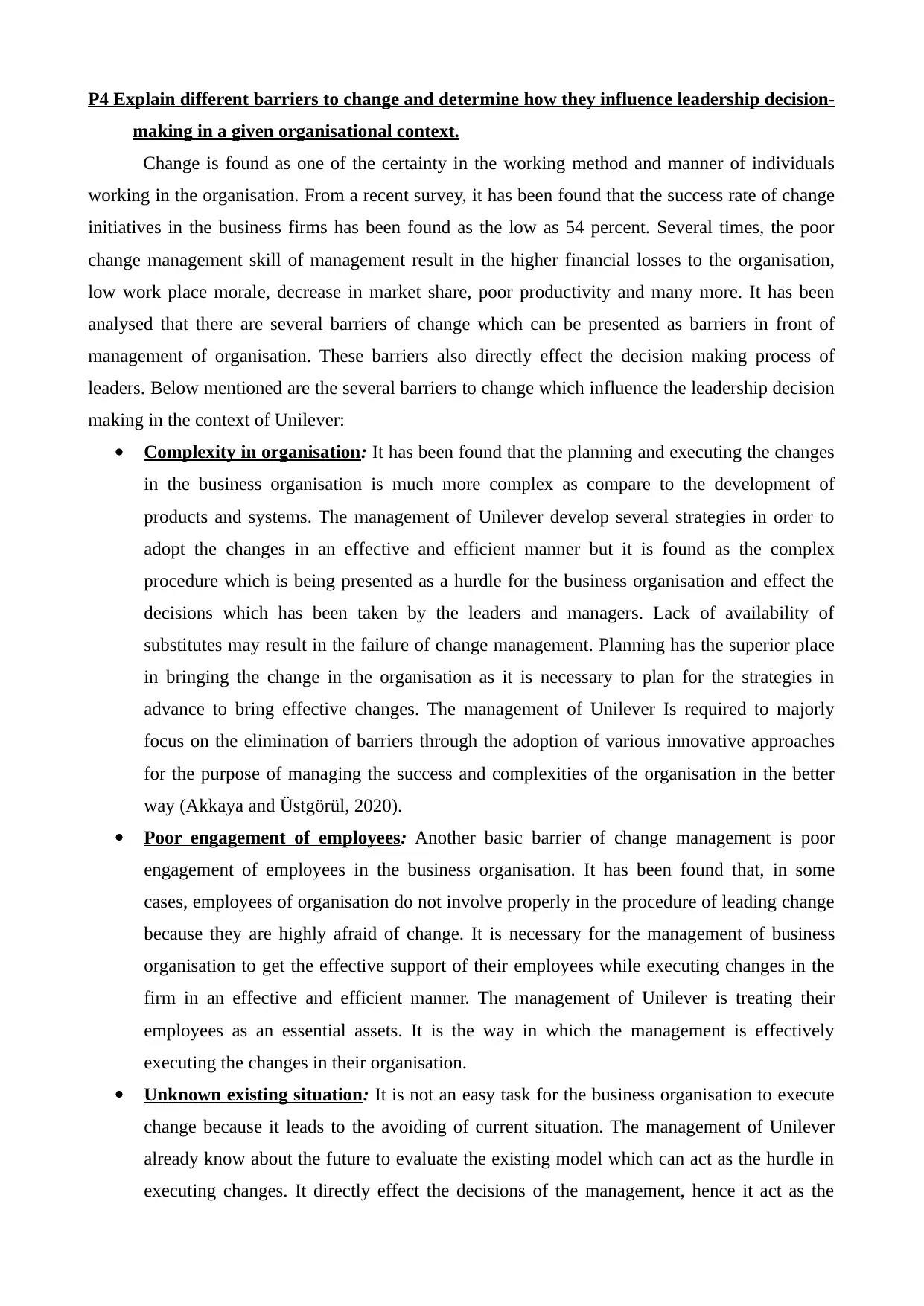
P4 Explain different barriers to change and determine how they influence leadership decision-
making in a given organisational context.
Change is found as one of the certainty in the working method and manner of individuals
working in the organisation. From a recent survey, it has been found that the success rate of change
initiatives in the business firms has been found as the low as 54 percent. Several times, the poor
change management skill of management result in the higher financial losses to the organisation,
low work place morale, decrease in market share, poor productivity and many more. It has been
analysed that there are several barriers of change which can be presented as barriers in front of
management of organisation. These barriers also directly effect the decision making process of
leaders. Below mentioned are the several barriers to change which influence the leadership decision
making in the context of Unilever:
Complexity in organisation: It has been found that the planning and executing the changes
in the business organisation is much more complex as compare to the development of
products and systems. The management of Unilever develop several strategies in order to
adopt the changes in an effective and efficient manner but it is found as the complex
procedure which is being presented as a hurdle for the business organisation and effect the
decisions which has been taken by the leaders and managers. Lack of availability of
substitutes may result in the failure of change management. Planning has the superior place
in bringing the change in the organisation as it is necessary to plan for the strategies in
advance to bring effective changes. The management of Unilever Is required to majorly
focus on the elimination of barriers through the adoption of various innovative approaches
for the purpose of managing the success and complexities of the organisation in the better
way (Akkaya and Üstgörül, 2020).
Poor engagement of employees: Another basic barrier of change management is poor
engagement of employees in the business organisation. It has been found that, in some
cases, employees of organisation do not involve properly in the procedure of leading change
because they are highly afraid of change. It is necessary for the management of business
organisation to get the effective support of their employees while executing changes in the
firm in an effective and efficient manner. The management of Unilever is treating their
employees as an essential assets. It is the way in which the management is effectively
executing the changes in their organisation.
Unknown existing situation: It is not an easy task for the business organisation to execute
change because it leads to the avoiding of current situation. The management of Unilever
already know about the future to evaluate the existing model which can act as the hurdle in
executing changes. It directly effect the decisions of the management, hence it act as the
making in a given organisational context.
Change is found as one of the certainty in the working method and manner of individuals
working in the organisation. From a recent survey, it has been found that the success rate of change
initiatives in the business firms has been found as the low as 54 percent. Several times, the poor
change management skill of management result in the higher financial losses to the organisation,
low work place morale, decrease in market share, poor productivity and many more. It has been
analysed that there are several barriers of change which can be presented as barriers in front of
management of organisation. These barriers also directly effect the decision making process of
leaders. Below mentioned are the several barriers to change which influence the leadership decision
making in the context of Unilever:
Complexity in organisation: It has been found that the planning and executing the changes
in the business organisation is much more complex as compare to the development of
products and systems. The management of Unilever develop several strategies in order to
adopt the changes in an effective and efficient manner but it is found as the complex
procedure which is being presented as a hurdle for the business organisation and effect the
decisions which has been taken by the leaders and managers. Lack of availability of
substitutes may result in the failure of change management. Planning has the superior place
in bringing the change in the organisation as it is necessary to plan for the strategies in
advance to bring effective changes. The management of Unilever Is required to majorly
focus on the elimination of barriers through the adoption of various innovative approaches
for the purpose of managing the success and complexities of the organisation in the better
way (Akkaya and Üstgörül, 2020).
Poor engagement of employees: Another basic barrier of change management is poor
engagement of employees in the business organisation. It has been found that, in some
cases, employees of organisation do not involve properly in the procedure of leading change
because they are highly afraid of change. It is necessary for the management of business
organisation to get the effective support of their employees while executing changes in the
firm in an effective and efficient manner. The management of Unilever is treating their
employees as an essential assets. It is the way in which the management is effectively
executing the changes in their organisation.
Unknown existing situation: It is not an easy task for the business organisation to execute
change because it leads to the avoiding of current situation. The management of Unilever
already know about the future to evaluate the existing model which can act as the hurdle in
executing changes. It directly effect the decisions of the management, hence it act as the
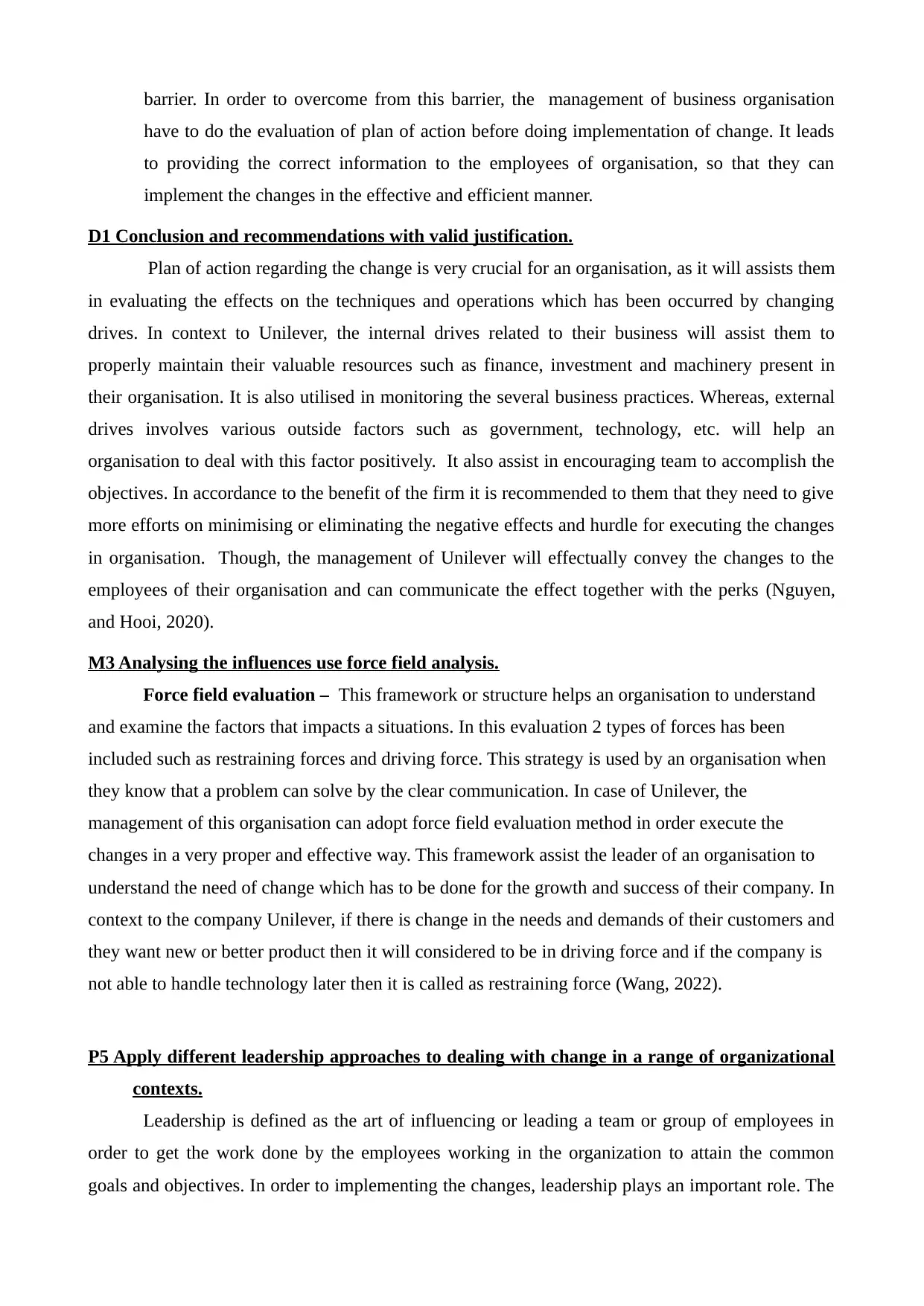
barrier. In order to overcome from this barrier, the management of business organisation
have to do the evaluation of plan of action before doing implementation of change. It leads
to providing the correct information to the employees of organisation, so that they can
implement the changes in the effective and efficient manner.
D1 Conclusion and recommendations with valid justification.
Plan of action regarding the change is very crucial for an organisation, as it will assists them
in evaluating the effects on the techniques and operations which has been occurred by changing
drives. In context to Unilever, the internal drives related to their business will assist them to
properly maintain their valuable resources such as finance, investment and machinery present in
their organisation. It is also utilised in monitoring the several business practices. Whereas, external
drives involves various outside factors such as government, technology, etc. will help an
organisation to deal with this factor positively. It also assist in encouraging team to accomplish the
objectives. In accordance to the benefit of the firm it is recommended to them that they need to give
more efforts on minimising or eliminating the negative effects and hurdle for executing the changes
in organisation. Though, the management of Unilever will effectually convey the changes to the
employees of their organisation and can communicate the effect together with the perks (Nguyen,
and Hooi, 2020).
M3 Analysing the influences use force field analysis.
Force field evaluation – This framework or structure helps an organisation to understand
and examine the factors that impacts a situations. In this evaluation 2 types of forces has been
included such as restraining forces and driving force. This strategy is used by an organisation when
they know that a problem can solve by the clear communication. In case of Unilever, the
management of this organisation can adopt force field evaluation method in order execute the
changes in a very proper and effective way. This framework assist the leader of an organisation to
understand the need of change which has to be done for the growth and success of their company. In
context to the company Unilever, if there is change in the needs and demands of their customers and
they want new or better product then it will considered to be in driving force and if the company is
not able to handle technology later then it is called as restraining force (Wang, 2022).
P5 Apply different leadership approaches to dealing with change in a range of organizational
contexts.
Leadership is defined as the art of influencing or leading a team or group of employees in
order to get the work done by the employees working in the organization to attain the common
goals and objectives. In order to implementing the changes, leadership plays an important role. The
have to do the evaluation of plan of action before doing implementation of change. It leads
to providing the correct information to the employees of organisation, so that they can
implement the changes in the effective and efficient manner.
D1 Conclusion and recommendations with valid justification.
Plan of action regarding the change is very crucial for an organisation, as it will assists them
in evaluating the effects on the techniques and operations which has been occurred by changing
drives. In context to Unilever, the internal drives related to their business will assist them to
properly maintain their valuable resources such as finance, investment and machinery present in
their organisation. It is also utilised in monitoring the several business practices. Whereas, external
drives involves various outside factors such as government, technology, etc. will help an
organisation to deal with this factor positively. It also assist in encouraging team to accomplish the
objectives. In accordance to the benefit of the firm it is recommended to them that they need to give
more efforts on minimising or eliminating the negative effects and hurdle for executing the changes
in organisation. Though, the management of Unilever will effectually convey the changes to the
employees of their organisation and can communicate the effect together with the perks (Nguyen,
and Hooi, 2020).
M3 Analysing the influences use force field analysis.
Force field evaluation – This framework or structure helps an organisation to understand
and examine the factors that impacts a situations. In this evaluation 2 types of forces has been
included such as restraining forces and driving force. This strategy is used by an organisation when
they know that a problem can solve by the clear communication. In case of Unilever, the
management of this organisation can adopt force field evaluation method in order execute the
changes in a very proper and effective way. This framework assist the leader of an organisation to
understand the need of change which has to be done for the growth and success of their company. In
context to the company Unilever, if there is change in the needs and demands of their customers and
they want new or better product then it will considered to be in driving force and if the company is
not able to handle technology later then it is called as restraining force (Wang, 2022).
P5 Apply different leadership approaches to dealing with change in a range of organizational
contexts.
Leadership is defined as the art of influencing or leading a team or group of employees in
order to get the work done by the employees working in the organization to attain the common
goals and objectives. In order to implementing the changes, leadership plays an important role. The
Secure Best Marks with AI Grader
Need help grading? Try our AI Grader for instant feedback on your assignments.
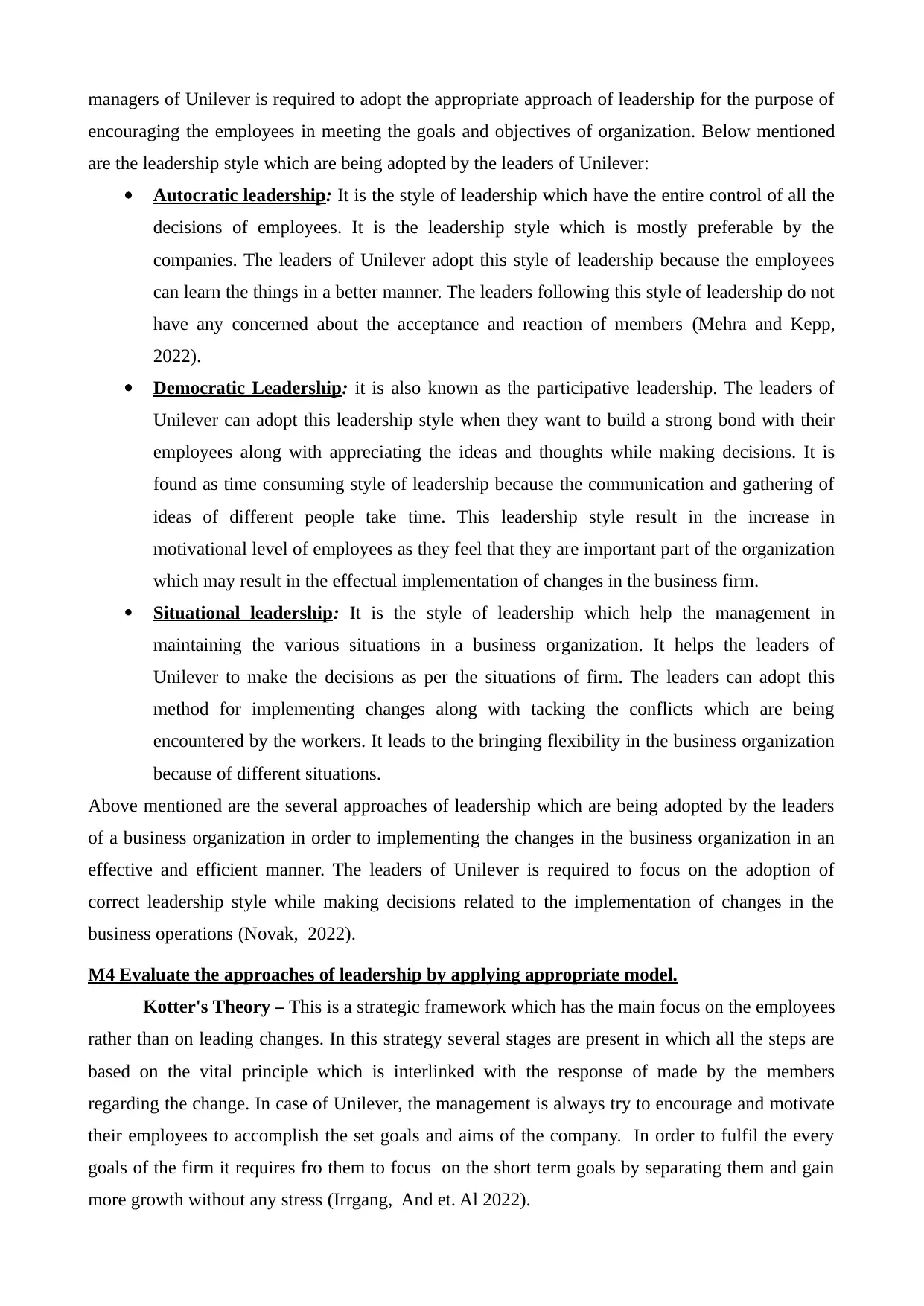
managers of Unilever is required to adopt the appropriate approach of leadership for the purpose of
encouraging the employees in meeting the goals and objectives of organization. Below mentioned
are the leadership style which are being adopted by the leaders of Unilever:
Autocratic leadership: It is the style of leadership which have the entire control of all the
decisions of employees. It is the leadership style which is mostly preferable by the
companies. The leaders of Unilever adopt this style of leadership because the employees
can learn the things in a better manner. The leaders following this style of leadership do not
have any concerned about the acceptance and reaction of members (Mehra and Kepp,
2022).
Democratic Leadership: it is also known as the participative leadership. The leaders of
Unilever can adopt this leadership style when they want to build a strong bond with their
employees along with appreciating the ideas and thoughts while making decisions. It is
found as time consuming style of leadership because the communication and gathering of
ideas of different people take time. This leadership style result in the increase in
motivational level of employees as they feel that they are important part of the organization
which may result in the effectual implementation of changes in the business firm.
Situational leadership: It is the style of leadership which help the management in
maintaining the various situations in a business organization. It helps the leaders of
Unilever to make the decisions as per the situations of firm. The leaders can adopt this
method for implementing changes along with tacking the conflicts which are being
encountered by the workers. It leads to the bringing flexibility in the business organization
because of different situations.
Above mentioned are the several approaches of leadership which are being adopted by the leaders
of a business organization in order to implementing the changes in the business organization in an
effective and efficient manner. The leaders of Unilever is required to focus on the adoption of
correct leadership style while making decisions related to the implementation of changes in the
business operations (Novak, 2022).
M4 Evaluate the approaches of leadership by applying appropriate model.
Kotter's Theory – This is a strategic framework which has the main focus on the employees
rather than on leading changes. In this strategy several stages are present in which all the steps are
based on the vital principle which is interlinked with the response of made by the members
regarding the change. In case of Unilever, the management is always try to encourage and motivate
their employees to accomplish the set goals and aims of the company. In order to fulfil the every
goals of the firm it requires fro them to focus on the short term goals by separating them and gain
more growth without any stress (Irrgang, And et. Al 2022).
encouraging the employees in meeting the goals and objectives of organization. Below mentioned
are the leadership style which are being adopted by the leaders of Unilever:
Autocratic leadership: It is the style of leadership which have the entire control of all the
decisions of employees. It is the leadership style which is mostly preferable by the
companies. The leaders of Unilever adopt this style of leadership because the employees
can learn the things in a better manner. The leaders following this style of leadership do not
have any concerned about the acceptance and reaction of members (Mehra and Kepp,
2022).
Democratic Leadership: it is also known as the participative leadership. The leaders of
Unilever can adopt this leadership style when they want to build a strong bond with their
employees along with appreciating the ideas and thoughts while making decisions. It is
found as time consuming style of leadership because the communication and gathering of
ideas of different people take time. This leadership style result in the increase in
motivational level of employees as they feel that they are important part of the organization
which may result in the effectual implementation of changes in the business firm.
Situational leadership: It is the style of leadership which help the management in
maintaining the various situations in a business organization. It helps the leaders of
Unilever to make the decisions as per the situations of firm. The leaders can adopt this
method for implementing changes along with tacking the conflicts which are being
encountered by the workers. It leads to the bringing flexibility in the business organization
because of different situations.
Above mentioned are the several approaches of leadership which are being adopted by the leaders
of a business organization in order to implementing the changes in the business organization in an
effective and efficient manner. The leaders of Unilever is required to focus on the adoption of
correct leadership style while making decisions related to the implementation of changes in the
business operations (Novak, 2022).
M4 Evaluate the approaches of leadership by applying appropriate model.
Kotter's Theory – This is a strategic framework which has the main focus on the employees
rather than on leading changes. In this strategy several stages are present in which all the steps are
based on the vital principle which is interlinked with the response of made by the members
regarding the change. In case of Unilever, the management is always try to encourage and motivate
their employees to accomplish the set goals and aims of the company. In order to fulfil the every
goals of the firm it requires fro them to focus on the short term goals by separating them and gain
more growth without any stress (Irrgang, And et. Al 2022).
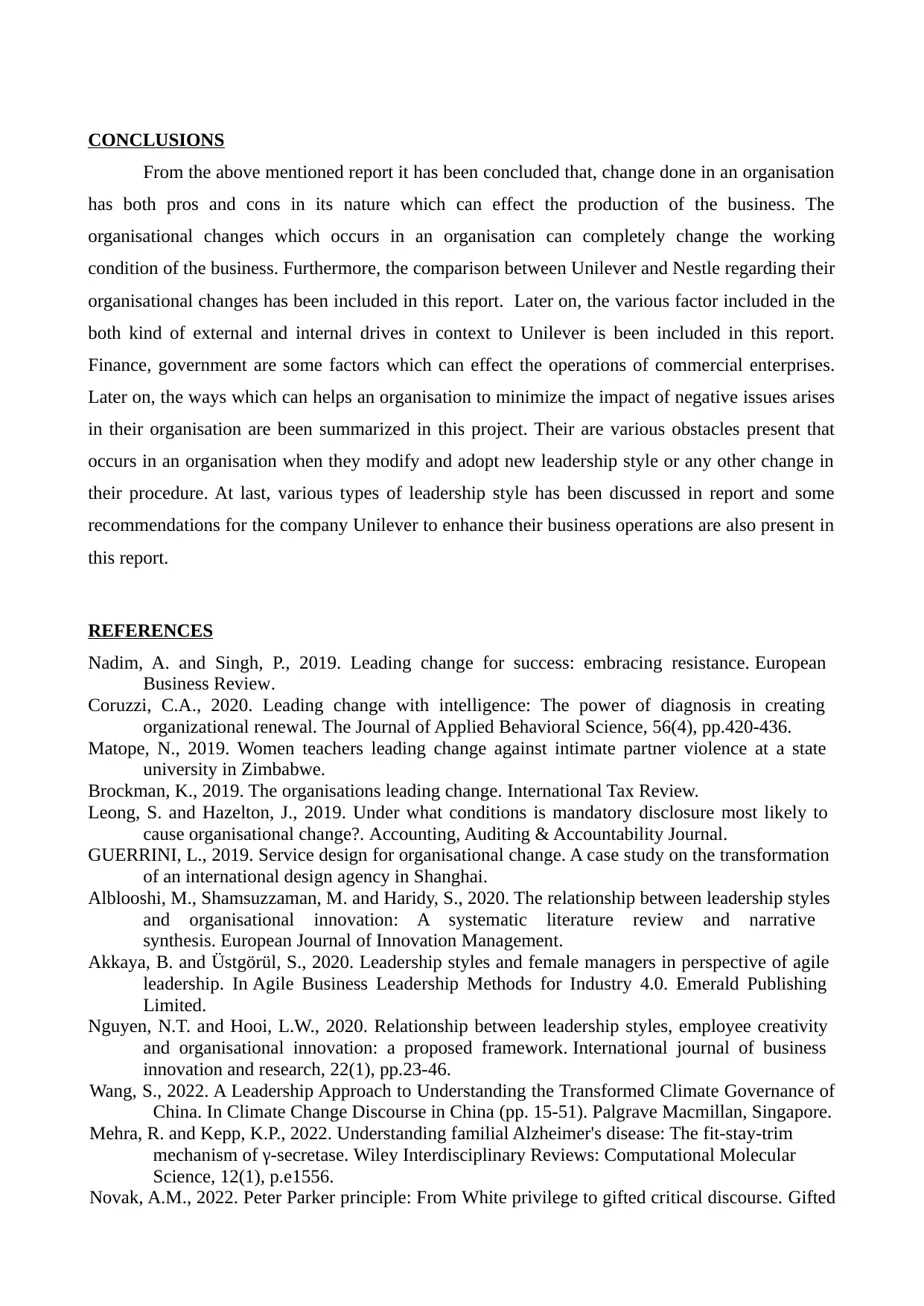
CONCLUSIONS
From the above mentioned report it has been concluded that, change done in an organisation
has both pros and cons in its nature which can effect the production of the business. The
organisational changes which occurs in an organisation can completely change the working
condition of the business. Furthermore, the comparison between Unilever and Nestle regarding their
organisational changes has been included in this report. Later on, the various factor included in the
both kind of external and internal drives in context to Unilever is been included in this report.
Finance, government are some factors which can effect the operations of commercial enterprises.
Later on, the ways which can helps an organisation to minimize the impact of negative issues arises
in their organisation are been summarized in this project. Their are various obstacles present that
occurs in an organisation when they modify and adopt new leadership style or any other change in
their procedure. At last, various types of leadership style has been discussed in report and some
recommendations for the company Unilever to enhance their business operations are also present in
this report.
REFERENCES
Nadim, A. and Singh, P., 2019. Leading change for success: embracing resistance. European
Business Review.
Coruzzi, C.A., 2020. Leading change with intelligence: The power of diagnosis in creating
organizational renewal. The Journal of Applied Behavioral Science, 56(4), pp.420-436.
Matope, N., 2019. Women teachers leading change against intimate partner violence at a state
university in Zimbabwe.
Brockman, K., 2019. The organisations leading change. International Tax Review.
Leong, S. and Hazelton, J., 2019. Under what conditions is mandatory disclosure most likely to
cause organisational change?. Accounting, Auditing & Accountability Journal.
GUERRINI, L., 2019. Service design for organisational change. A case study on the transformation
of an international design agency in Shanghai.
Alblooshi, M., Shamsuzzaman, M. and Haridy, S., 2020. The relationship between leadership styles
and organisational innovation: A systematic literature review and narrative
synthesis. European Journal of Innovation Management.
Akkaya, B. and Üstgörül, S., 2020. Leadership styles and female managers in perspective of agile
leadership. In Agile Business Leadership Methods for Industry 4.0. Emerald Publishing
Limited.
Nguyen, N.T. and Hooi, L.W., 2020. Relationship between leadership styles, employee creativity
and organisational innovation: a proposed framework. International journal of business
innovation and research, 22(1), pp.23-46.
Wang, S., 2022. A Leadership Approach to Understanding the Transformed Climate Governance of
China. In Climate Change Discourse in China (pp. 15-51). Palgrave Macmillan, Singapore.
Mehra, R. and Kepp, K.P., 2022. Understanding familial Alzheimer's disease: The fit‐stay‐trim
mechanism of γ‐secretase. Wiley Interdisciplinary Reviews: Computational Molecular
Science, 12(1), p.e1556.
Novak, A.M., 2022. Peter Parker principle: From White privilege to gifted critical discourse. Gifted
From the above mentioned report it has been concluded that, change done in an organisation
has both pros and cons in its nature which can effect the production of the business. The
organisational changes which occurs in an organisation can completely change the working
condition of the business. Furthermore, the comparison between Unilever and Nestle regarding their
organisational changes has been included in this report. Later on, the various factor included in the
both kind of external and internal drives in context to Unilever is been included in this report.
Finance, government are some factors which can effect the operations of commercial enterprises.
Later on, the ways which can helps an organisation to minimize the impact of negative issues arises
in their organisation are been summarized in this project. Their are various obstacles present that
occurs in an organisation when they modify and adopt new leadership style or any other change in
their procedure. At last, various types of leadership style has been discussed in report and some
recommendations for the company Unilever to enhance their business operations are also present in
this report.
REFERENCES
Nadim, A. and Singh, P., 2019. Leading change for success: embracing resistance. European
Business Review.
Coruzzi, C.A., 2020. Leading change with intelligence: The power of diagnosis in creating
organizational renewal. The Journal of Applied Behavioral Science, 56(4), pp.420-436.
Matope, N., 2019. Women teachers leading change against intimate partner violence at a state
university in Zimbabwe.
Brockman, K., 2019. The organisations leading change. International Tax Review.
Leong, S. and Hazelton, J., 2019. Under what conditions is mandatory disclosure most likely to
cause organisational change?. Accounting, Auditing & Accountability Journal.
GUERRINI, L., 2019. Service design for organisational change. A case study on the transformation
of an international design agency in Shanghai.
Alblooshi, M., Shamsuzzaman, M. and Haridy, S., 2020. The relationship between leadership styles
and organisational innovation: A systematic literature review and narrative
synthesis. European Journal of Innovation Management.
Akkaya, B. and Üstgörül, S., 2020. Leadership styles and female managers in perspective of agile
leadership. In Agile Business Leadership Methods for Industry 4.0. Emerald Publishing
Limited.
Nguyen, N.T. and Hooi, L.W., 2020. Relationship between leadership styles, employee creativity
and organisational innovation: a proposed framework. International journal of business
innovation and research, 22(1), pp.23-46.
Wang, S., 2022. A Leadership Approach to Understanding the Transformed Climate Governance of
China. In Climate Change Discourse in China (pp. 15-51). Palgrave Macmillan, Singapore.
Mehra, R. and Kepp, K.P., 2022. Understanding familial Alzheimer's disease: The fit‐stay‐trim
mechanism of γ‐secretase. Wiley Interdisciplinary Reviews: Computational Molecular
Science, 12(1), p.e1556.
Novak, A.M., 2022. Peter Parker principle: From White privilege to gifted critical discourse. Gifted
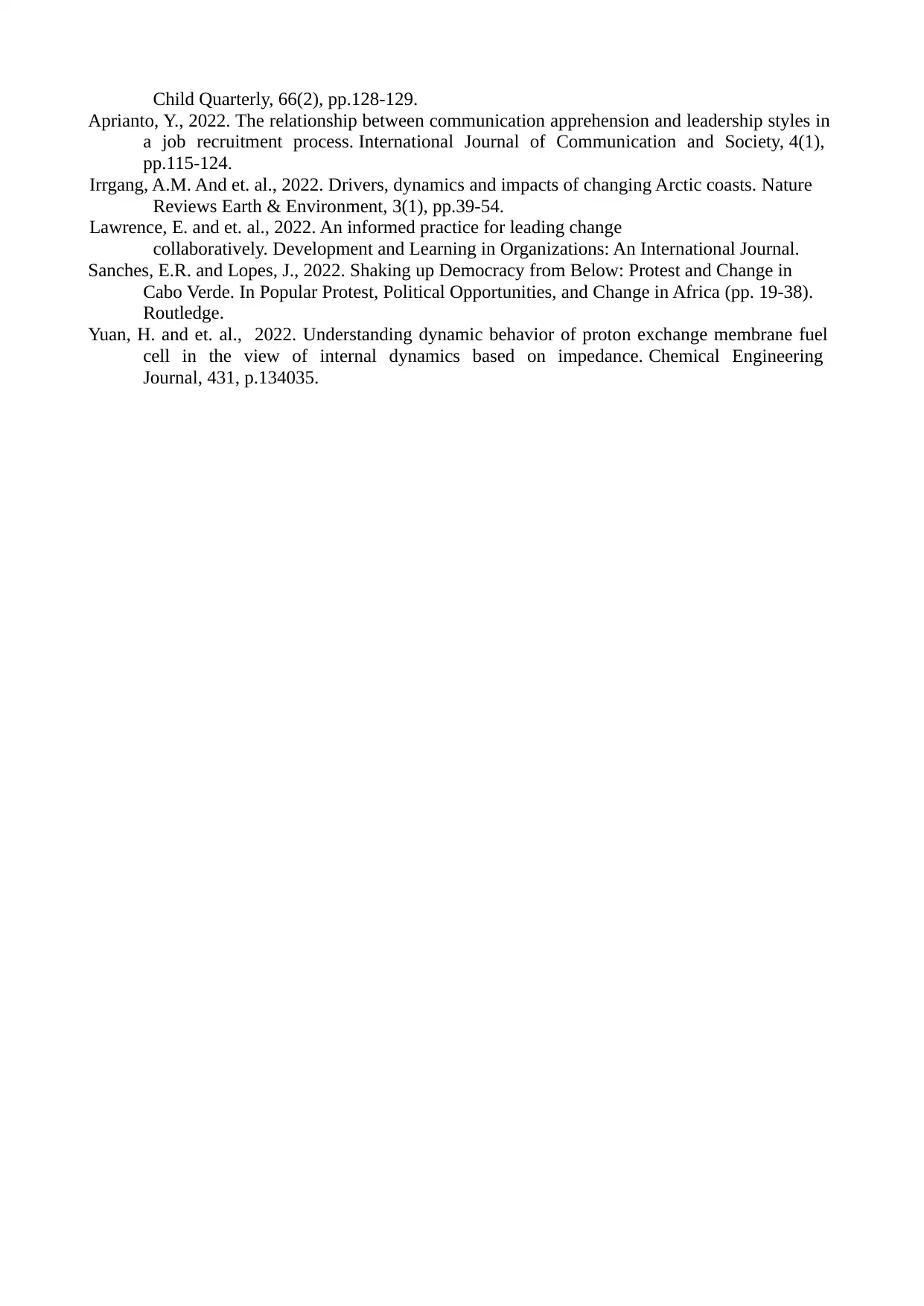
Child Quarterly, 66(2), pp.128-129.
Aprianto, Y., 2022. The relationship between communication apprehension and leadership styles in
a job recruitment process. International Journal of Communication and Society, 4(1),
pp.115-124.
Irrgang, A.M. And et. al., 2022. Drivers, dynamics and impacts of changing Arctic coasts. Nature
Reviews Earth & Environment, 3(1), pp.39-54.
Lawrence, E. and et. al., 2022. An informed practice for leading change
collaboratively. Development and Learning in Organizations: An International Journal.
Sanches, E.R. and Lopes, J., 2022. Shaking up Democracy from Below: Protest and Change in
Cabo Verde. In Popular Protest, Political Opportunities, and Change in Africa (pp. 19-38).
Routledge.
Yuan, H. and et. al., 2022. Understanding dynamic behavior of proton exchange membrane fuel
cell in the view of internal dynamics based on impedance. Chemical Engineering
Journal, 431, p.134035.
Aprianto, Y., 2022. The relationship between communication apprehension and leadership styles in
a job recruitment process. International Journal of Communication and Society, 4(1),
pp.115-124.
Irrgang, A.M. And et. al., 2022. Drivers, dynamics and impacts of changing Arctic coasts. Nature
Reviews Earth & Environment, 3(1), pp.39-54.
Lawrence, E. and et. al., 2022. An informed practice for leading change
collaboratively. Development and Learning in Organizations: An International Journal.
Sanches, E.R. and Lopes, J., 2022. Shaking up Democracy from Below: Protest and Change in
Cabo Verde. In Popular Protest, Political Opportunities, and Change in Africa (pp. 19-38).
Routledge.
Yuan, H. and et. al., 2022. Understanding dynamic behavior of proton exchange membrane fuel
cell in the view of internal dynamics based on impedance. Chemical Engineering
Journal, 431, p.134035.
1 out of 13
Related Documents
Your All-in-One AI-Powered Toolkit for Academic Success.
+13062052269
info@desklib.com
Available 24*7 on WhatsApp / Email
![[object Object]](/_next/static/media/star-bottom.7253800d.svg)
Unlock your academic potential
© 2024 | Zucol Services PVT LTD | All rights reserved.





